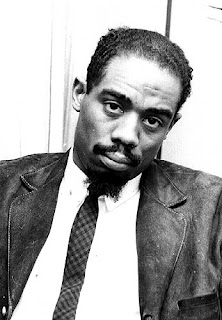A definitive jazz multi-instrumentalist, Eric Dolphy established deeply original voices on his three primary instruments– the bass clarinet, alto saxophone, and flute. Dolphy pioneered the use of the bass clarinet as a solo improvising instrument, and, with Coleman Hawkins and Sonny Rollins, he is one of the earliest saxophonists to record solo improvisations. Beloved by his peers for his compassion and enthusiasm, Dolphy’s unique musical perspective helped shape the emerging avant-garde of the 1960s, though he remained firmly rooted in jazz tradition until his premature death.
Eric Allan Dolphy was born in Los Angeles in 1928, the only child of Sadie and Eric Dolphy Sr.–both of West-Indian descent. After demonstrating promise on his elementary school-issued harmonica, Dolphy picked up the clarinet, and while still in junior high school he received a scholarship to study at the University of Southern California School of Music. Encouraging his talents, Dolphy’s parents built him a shed behind their home in which he could rehearse with his various ensembles. After graduating from high school, Dolphy studied music at Los Angeles City College, and he made his first known recorded appearances with the Roy Porter band in 1949. In 1950, Dolphy entered the U.S. Army and was stationed at Fort Lewis, Washington.
Following his discharge Dolphy worked in Los Angeles in relative obscurity for several years until, in 1959, he earned a position in drummer Chico Hamilton’s quintet. After touring extensively, Dolphy left Hamilton and moved to New York City, where he re-established his relationship with fellow Californian Charles Mingus, a personal and musical relationship which would grow until Dolphy’s death.
Early recordings with Mingus highlight Dolphy’s highly developed and original musical interpretations. Dolphy’s style employed wide intervallic leaps, inimitable harmonies, and speech and animal-like inflections (Dolphy supposedly regularly rehearsed among flocks of birds). The exposure Dolphy received as part of Mingus’ Jazz Workshop led to numerous opportunities as both a sideman and a leader, including Dolphy’s own 1960 debut, Outward Bound. Highlights of Eric Dolphy’s recording career as a leader include several studio albums for Prestige, one for Blue Note (the remarkable Out to Lunch), and three albums worth of live material from his and trumpeter Booker Little’s two-week residency at the Five Spot in New York. As a sideman Dolphy also made significant contributions to such albums as Andrew Hill’s Point of Departure, Oliver Nelson’s The Blues and The Abstract Truth, Max Roach’s Percussion Bitter Sweet, Booker Little’s Out Front, and Ornette Coleman’s seminal double quartet album Free Jazz.
From 1961 to 1963 Eric Dolphy also regularly performed with John Coltrane’s classic quartet where he generated much of his most acclaimed work. With Coltrane and pianist McCoy Tyner, Dolphy arranged the orchestrations of Coltrane’s 1961 album, Africa/Brass, and he was a major contributor to Coltrane’s Live at the Village Vanguard recordings of the same year. Improved musical documentation of this period has shown just how integral Dolphy was to the ensemble, a point which was minimized by the initial records. In many respects Coltrane regarded Dolphy as uniquely suited to explore his musical ideas, and as with Mingus, the influence was clearly reciprocal.
Following the final performances of Charles Mingus’ 1964 European tour, Dolphy remained abroad, seeking improved work opportunities and greater individual recognition before his forthcoming marriage. Eric Dolphy died of undiagnosed diabetes in Berlin on 21 June, 1964, at the age of 36.




















